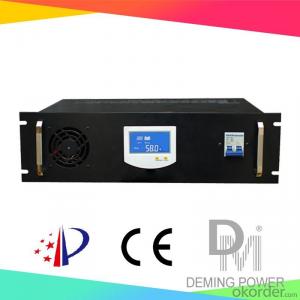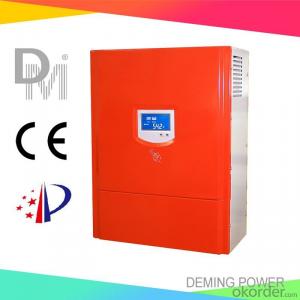Solar Charge Controller 220V 30A/50A/60A/80A for off grid solar power system and RS485 available
- Loading Port:
- Qingdao
- Payment Terms:
- TT OR LC
- Min Order Qty:
- 1 PCS
- Supply Capability:
- 1000 PCS/month
OKorder Service Pledge
OKorder Financial Service
You Might Also Like
Properties of the solar charge controller
1. Design for off-grid solar power system.
2. Applicable to different kinds of batteries.
3. Modular design with simple structure and easy maintenance.
4. Automatic power control function.
5. LCD display: Solar panel current, solar panel voltage, solar panel power, battery group voltage, charge current.
6. Perfect protection function: Solar reverse charge protection, Solar reverse connection protection, Battery reverse connection protection, Battery overcharge protection, Battery over current protection etc ,thus the system has higher reliability.
Technical parameters of the solar charge controller
Model | 220V30A | 220V50A | 220V60A | 220V80A |
Battery group rated voltage | 220Vdc | 220Vdc | 220Vdc | 220Vdc |
PV open circuit voltage | 500V | 500V | 500V | 500V |
PV Rated current | 30A | 50A | 60A | 80A |
PV Max. power | 6600Wp | 11000Wp | 13200Wp | 17600Wp |
Input PV module road number | 1 | 1 | 1 | 1 |
Function | Auto stop charge, auto recharge voltage; Protection: connecting contrary, over current, short circuit, over heat etc. | |||
Display mode | LCD | |||
Display content | solar panel voltage, solar panel current, solar panel power, battery voltage, charge current | |||
Floating Charge Voltage (adjustable) | 248Vdc | 248Vdc | 248Vdc | 248Vdc |
Stop charge voltage | 260Vdc±1% | 260Vdc±1% | 260Vdc±1% | 260Vdc±1% |
Recharge voltage | 243Vdc±1% | 243Vdc±1% | 243Vdc±1% | 243Vdc±1% |
Voltage drop between PV and battery | 1.5V | |||
Max itself power consumption | 100mA-150mA | |||
Work environment temperature | -30-60°C | |||
Relative humidity | <90% No condensation | |||
Applicable altitude | <3000m The rated power should be reduced when it is higher than 2000m | |||
Noise (1m) | <40dB | |||
Degree of protection | IP20(Indoor) | |||
Cooling method | Forced air cooling | |||
*Communication interface (optional) | RS485/USB/GPRS/Ethernet | |||
*Temperature compensation(optional) | -4mv/°C/2V,-35°C~+80°C,Accuracy:±1°C | |||
Product size (mm) | 520*430*200 | |||
Weight | 12Kg | |||
*Above parameter only for reference. Could be custom made to user specifications.
- Q:How do you protect a solar controller from lightning strikes?
- To protect a solar controller from lightning strikes, it is important to employ a combination of preventive measures. Firstly, ensure that the solar controller is installed in a grounded location, ideally using a grounding rod that is installed deep into the ground. Additionally, it is recommended to install surge protection devices (SPDs) that are specifically designed to mitigate lightning-induced surges. These SPDs should be installed both at the solar panel array and at the electrical equipment, including the solar controller. Lastly, utilizing proper lightning arrestors and lightning rods in the vicinity of the solar system can divert lightning strikes away, providing an extra layer of protection.
- Q:Can a solar controller be used with solar panel ground racks?
- Yes, a solar controller can be used with solar panel ground racks. The solar controller regulates the flow of electricity from the solar panels to the connected batteries or grid, regardless of whether the panels are mounted on the ground or on rooftops.
- Q:What are the common failure modes of a solar controller?
- The common failure modes of a solar controller include overcharging or undercharging of batteries, voltage spikes or fluctuations, failure to regulate the charge or discharge process, and damaged or malfunctioning components such as diodes, capacitors, or circuit boards.
- Q:How does a solar controller handle different charging stages?
- A solar controller manages different charging stages by regulating the flow of electricity from the solar panels to the battery. It monitors the battery's voltage levels and adjusts the charging process accordingly. During the bulk stage, it allows maximum current to charge the battery rapidly. In the absorption stage, it reduces the charging current while maintaining a constant voltage to ensure the battery is fully charged. Finally, during the float stage, the controller maintains a lower voltage to prevent overcharging and keep the battery in a fully charged state.
- Q:Can a solar controller be used with solar-powered gate openers?
- Solar-powered gate openers can utilize a solar controller, which plays a crucial role in optimizing and regulating battery charging from solar panels. Solar controllers are essential components in any solar power system, as they effectively manage electricity flow from the panels to the battery. By doing so, they ensure efficient battery charging and prevent overcharging and over-discharging, thus prolonging the battery's lifespan. Therefore, it is highly advisable to incorporate a solar controller into a solar-powered gate opener system to guarantee its proper operation and long-term functionality.
- Q:Can a solar controller be used with a generator backup?
- Yes, a solar controller can be used with a generator backup. In fact, it is quite common for solar systems to be combined with generator backups in order to provide continuous power supply. The solar controller acts as the interface between the solar panels and the battery bank, regulating the flow of energy and ensuring that the battery is not overcharged or drained. In the event of insufficient solar power, the generator backup can be activated to provide additional electricity to the system. This combination allows for a reliable and sustainable power solution, utilizing both renewable energy from the sun and backup power from a generator when needed.
- Q:Can a solar controller be used in an agricultural solar system?
- Yes, a solar controller can be used in an agricultural solar system. The solar controller helps regulate the charging and discharging of energy from the solar panels to the batteries, ensuring optimal performance and energy efficiency. In an agricultural solar system, the solar controller can effectively manage the power supply to various components such as irrigation systems, pumps, and lighting, helping to maximize productivity and sustainability.
- Q:What are the maintenance requirements for a solar controller?
- The maintenance requirements for a solar controller are generally minimal. Regularly inspecting the controller for any signs of physical damage or loose connections is important. Additionally, cleaning the solar controller and its surrounding area from dust or debris can ensure optimal performance. It is also advisable to check the battery voltage and ensure proper charging to maintain the efficiency of the solar controller.
- Q:Can a solar controller be used with multiple solar panels?
- Yes, a solar controller can be used with multiple solar panels. The solar controller regulates the flow of electricity from the solar panels to the battery or load, regardless of the number of panels connected to it.
- Q:How does a solar controller handle battery desulfation?
- A solar controller handles battery desulfation by periodically applying high voltage pulses to the battery, which helps break down and remove sulfation buildup on the battery plates. This process rejuvenates the battery and improves its overall performance and lifespan.
1. Manufacturer Overview |
|
|---|---|
| Location | |
| Year Established | |
| Annual Output Value | |
| Main Markets | |
| Company Certifications | |
2. Manufacturer Certificates |
|
|---|---|
| a) Certification Name | |
| Range | |
| Reference | |
| Validity Period | |
3. Manufacturer Capability |
|
|---|---|
| a)Trade Capacity | |
| Nearest Port | |
| Export Percentage | |
| No.of Employees in Trade Department | |
| Language Spoken: | |
| b)Factory Information | |
| Factory Size: | |
| No. of Production Lines | |
| Contract Manufacturing | |
| Product Price Range | |
Send your message to us
Solar Charge Controller 220V 30A/50A/60A/80A for off grid solar power system and RS485 available
- Loading Port:
- Qingdao
- Payment Terms:
- TT OR LC
- Min Order Qty:
- 1 PCS
- Supply Capability:
- 1000 PCS/month
OKorder Service Pledge
OKorder Financial Service
Similar products
New products
Hot products
Hot Searches
Related keywords
































